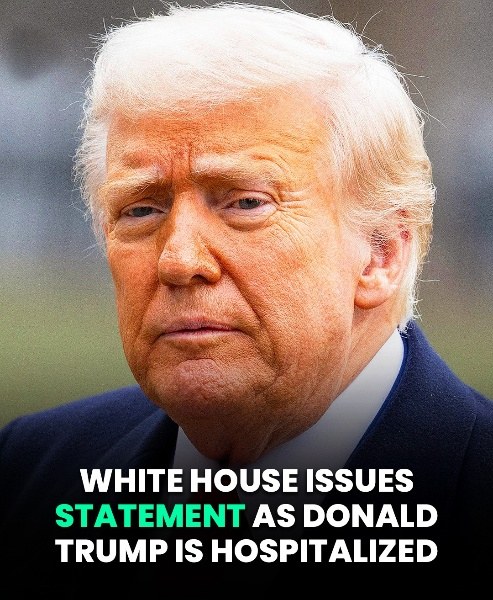The White House has confirmed that President Donald Trump was taken to Walter Reed National Military Medical Center early Friday morning for what officials describe as a “routine yearly checkup.” The visit, however, has stirred fresh speculation about the 79-year-old leader’s health after months of public concern and mixed messaging from his administration.

White House Press Secretary Karoline Leavitt told reporters that the president’s hospital trip was “part of a scheduled visit” that also included a meeting with troops and remarks to military personnel. “While there, President Trump will complete his annual medical evaluation,” Leavitt said. “He will then return to the White House later in the afternoon.”
The statement was intended to sound routine. But few in Washington believe it is. Trump’s last full physical examination was conducted only six months ago, raising questions about why another “yearly” checkup was suddenly necessary. Sources close to the administration described this week’s trip as “precautionary,” though they acknowledged that the president’s doctors have been monitoring “circulatory and fatigue-related issues” for several months.
In July, photographs surfaced showing visible bruising on Trump’s hands and swelling around his ankles as he boarded Air Force One. At the time, aides downplayed the images as “normal signs of aging,” but the visual evidence sparked days of speculation online. Those concerns intensified after the BBC reported that Trump had been diagnosed with chronic venous insufficiency — a condition that impairs blood flow from the legs to the heart, often causing swelling and discoloration.
Medical experts note that the condition is common and generally non-life-threatening. “Chronic venous insufficiency affects roughly one in three people over the age of seventy,” said Dr. Patricia Landers, a vascular specialist at Johns Hopkins. “It’s manageable with treatment and lifestyle changes, but it can lead to complications if ignored — especially in individuals with sedentary routines or cardiovascular history.”
The administration has offered little public detail about how the condition is being treated, though Leavitt emphasized Friday that “the president remains in excellent spirits and continues to maintain a full schedule.” According to her, Trump planned to hold virtual briefings with national security advisers later in the day, pending clearance from his physicians.
The timing of the visit, however, has prompted renewed whispers inside the Beltway. Over the summer, conspiracy theories claiming the president had secretly died circulated online after he briefly disappeared from public appearances. Trump laughed off the rumors, telling reporters, “I didn’t hear that one — that’s pretty serious stuff,” before posting on social media: “NEVER FELT BETTER IN MY LIFE.”
At the time, he told journalists aboard Air Force One, “Good heart, good soul — a very good soul. I wanted to be a little different than Biden. I took a cognitive test, and I don’t know what to tell you other than I got every answer right.” The remark drew laughter from his aides but did little to quiet speculation about his stamina.
Trump’s age and health have long been a subject of political fascination. Supporters have portrayed him as tireless and energetic — a man who thrives on long workdays, late-night calls, and minimal sleep. Critics argue that his unpredictable schedule and poor diet are signs of a leader who refuses to acknowledge his physical limitations. This morning’s hospital visit has reignited both narratives.
“He’s an older man under constant stress,” said Dr. Howard Klein, a cardiologist in New York who has followed the president’s health reports for years. “Even if the visit is routine, these optics matter. Two hospital visits in half a year raise legitimate medical questions.”
Administration officials insist that the trip was planned in advance. Still, the atmosphere around the West Wing was notably tense Friday morning. Motorcades rolled out shortly after sunrise, and the president was seen walking to Marine One under the watch of Secret Service agents. Cameras captured him waving to reporters but taking no questions.
Walter Reed has served as the medical hub for American presidents for decades — a place where routine visits often blur with moments of crisis. It’s where Ronald Reagan recovered from his assassination attempt, where George W. Bush underwent colonoscopy exams, and where both Donald Trump and Joe Biden have had evaluations during their presidencies.
Trump’s previous trip to Walter Reed, in 2020, became infamous after leaks suggested he had experienced chest discomfort and underwent unscheduled tests. The White House at the time insisted it was “a quick exam ahead of schedule,” but details remained murky. The following year, his then-physician, Dr. Sean Conley, released a brief statement asserting that “the president remains in very good health overall.”
This latest visit comes amid heightened political stakes. With a grueling election year approaching and Trump’s campaign schedule intensifying, every appearance — or absence — carries political weight. The White House has worked aggressively to project an image of vitality, showcasing photos of Trump on the golf course and at rallies.
“He’s doing fine — the man’s unstoppable,” one aide told Fox News. “He’s getting a checkup because that’s what responsible people do at his age. The media can spin it however they want, but he’s working, traveling, and ready to keep leading.”
Yet even some allies concede that concern within Trump’s inner circle has grown. “He pushes himself too hard,” said a longtime adviser. “He doesn’t like rest, doesn’t like slowing down. But sometimes the body decides for you.”
If Trump’s condition is indeed limited to venous insufficiency, doctors say it would explain the swelling and bruising observed over the summer. “It’s a circulatory issue, not a cardiac one,” explained Dr. Landers. “But prolonged inflammation can increase risk for other complications, especially with extensive travel or dehydration.”
For now, the White House maintains that no serious findings have emerged. Leavitt told reporters that the president completed “a routine series of tests” and that his doctors were “very pleased with the results.” Trump was later seen returning to the White House, appearing energetic and speaking briefly to staff before heading inside.
“Everything’s good,” he reportedly told one aide, flashing a thumbs-up.
But the public remains skeptical. Across social media, hashtags like #TrumpHealth and #WalterReed trended throughout the day. Commentators debated whether the White House was downplaying a more significant issue, pointing to the administration’s history of vague or inconsistent health disclosures.
For now, there are no official updates on when Trump will release his medical report — something he has done intermittently in past years, often with exaggerated claims. “He’ll tell you he’s the healthiest president in history,” one former official joked, “and maybe he believes it. But no one stays invincible forever.”
As Trump reportedly considers a trip to the Middle East in the coming weeks, questions about his endurance will follow him. Allies insist he’s fit to lead; critics doubt it. Somewhere in between lies the truth — a 79-year-old man, defiant as ever, facing the realities of time while refusing to slow down.
For a presidency defined by spectacle and strength, even a hospital visit becomes political theater. And yet, beneath the noise, the moment feels simple: a powerful man, mortal like everyone else, stepping once again into Walter Reed’s sterile halls, where the lights are bright, the tests are clinical, and the future — for all his bravado — remains uncertain.




